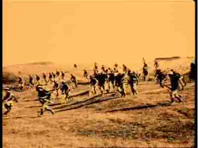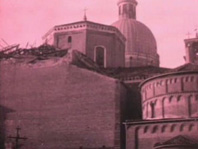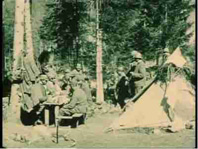 For EFG1914, the Danish Film Institute is about digitise a total of 50 hours of film related to World War One. The following three films focus on the War in Italy and are viewable on the European Film Gateway now.
For EFG1914, the Danish Film Institute is about digitise a total of 50 hours of film related to World War One. The following three films focus on the War in Italy and are viewable on the European Film Gateway now.
Background: Prior to the outbreak of war in August 1914, Italy had tended to side with Germany and Austria-Hungary. To begin with Italy kept out of the war. However, tempted by offers of large sections of territory in the Adriatic Sea region – Tyrol, Dalmatia and Istria once the war was won, Italy entered the conflict in April 1915 on the side of the Allies.
The Italian Front is the name given to the fighting that took place along the mainly alpine border between Italy and Austria-Hungary (A-H). The Italians only managed to advance a short way into enemy territory south of the Julian Alps and here between 1915 and 1917 there were twelve battles fought along the river Isonzo, just inside A-H territory. In October and November 1917, after being defeated at the battle of Caporetto by a combination of A-H and German troops and suffering losses of around 300 000 men, the Italians were pushed back to the river Piave near Venice. They only advanced in late 1918, aided by French and British units, defeating the Central Powers at the battle of Vittorio Veneto.
By the end of hostilities in 1918, 689 000 Italians soldiers were dead, 950 000 were wounded and 250 000 were crippled for life; plus an estimated 600 000 civilians who had died because of privation caused by the conflict. Financially it had cost more than the government had spent in the previous 50 years – and Italy had only been in the war three years. (Everett Sharp, Oxford University)
1. Bersaglieri d’Italia alle grandi manovre [Italian Alpine Commandos], IT 1915
 This extract of a newsreel of the First World War shows bicycle-borne bersaglieri demonstrating their riding skills on parade and on manoeuvres, and finally swarming up an equestrian monument to pose for the camera. (David Robinson, The Pordenone Silent Festival Catalogue 2008)
This extract of a newsreel of the First World War shows bicycle-borne bersaglieri demonstrating their riding skills on parade and on manoeuvres, and finally swarming up an equestrian monument to pose for the camera. (David Robinson, The Pordenone Silent Festival Catalogue 2008)
2. Et luftangreb paa Padua [An aerial attack on Padua], IT 1917
 With Danish intertitles. Between 28-30 December 1917, Padua suffered three air raids by Austrian aircraft. After the first, The Times of London reported: “December 29. – Yesterday evening at 9 p.m. enemy airmen, true to their innate barbarian impulses, which have been revived by the defeat they suffered on December 26 at Treviso, bombarded the inhabited parts of Treviso, Montebelluna, Castelfranco, and Padua, all open cities…“In the centre of Padua, where the population is densest and the finest monuments are more numerous, eight bombs were dropped, killing 13 persons and wounding 60. Among the casualties, for the most part women and children, there are only six soldiers. No monument was damaged. There was no damage done or casualties caused in the other cities.” The subsequent raids, however, did cause damage to the Cathedral, bringing a protest from the Pope, as well as more casualties. The newsreel shows the Cathedral, among other extensive damage to the city.The film opens with soldiers inspecting a crashed Austrian plane, and ends with the funeral of the victims of the bombardment. (David Robinson, The Pordenone Silent Festival Catalogue 2008)
With Danish intertitles. Between 28-30 December 1917, Padua suffered three air raids by Austrian aircraft. After the first, The Times of London reported: “December 29. – Yesterday evening at 9 p.m. enemy airmen, true to their innate barbarian impulses, which have been revived by the defeat they suffered on December 26 at Treviso, bombarded the inhabited parts of Treviso, Montebelluna, Castelfranco, and Padua, all open cities…“In the centre of Padua, where the population is densest and the finest monuments are more numerous, eight bombs were dropped, killing 13 persons and wounding 60. Among the casualties, for the most part women and children, there are only six soldiers. No monument was damaged. There was no damage done or casualties caused in the other cities.” The subsequent raids, however, did cause damage to the Cathedral, bringing a protest from the Pope, as well as more casualties. The newsreel shows the Cathedral, among other extensive damage to the city.The film opens with soldiers inspecting a crashed Austrian plane, and ends with the funeral of the victims of the bombardment. (David Robinson, The Pordenone Silent Festival Catalogue 2008)
 The unindentified documentary film, distributed in Denmark with Danish intertitles, is a compilation made of probably three (?) different pieces from different short documentaries about the Italian front. Since it was not possible to film the actual combat, its more about showing locations and logistics: trenches in the mountains, soldiers transporting war machinery in high altitude, elite Italian Alpini in mountaineering equipment, pigeons transporting messages etc. The second part of the film shows a beautiful Italian landscape (“the poetry of waterfalls”), an imagery which completely contrasts the horrors of war. The third part shows the daily life of prisoners of war (POW): In the kitchen, doing exercises, etc. Like most of the so called “actualités”, this film serves propaganda purposes. All countries involved in the conflict wanted to show Neutral countries of their exemplary treatment of POWs; the truthfulness of these moving images is however difficult to judge.
The unindentified documentary film, distributed in Denmark with Danish intertitles, is a compilation made of probably three (?) different pieces from different short documentaries about the Italian front. Since it was not possible to film the actual combat, its more about showing locations and logistics: trenches in the mountains, soldiers transporting war machinery in high altitude, elite Italian Alpini in mountaineering equipment, pigeons transporting messages etc. The second part of the film shows a beautiful Italian landscape (“the poetry of waterfalls”), an imagery which completely contrasts the horrors of war. The third part shows the daily life of prisoners of war (POW): In the kitchen, doing exercises, etc. Like most of the so called “actualités”, this film serves propaganda purposes. All countries involved in the conflict wanted to show Neutral countries of their exemplary treatment of POWs; the truthfulness of these moving images is however difficult to judge.
View an in-depth analysis of “Italien 1918” by Everett Sharp, military historian at Oxford University.
 Deutsch
Deutsch English
English Čeština
Čeština Dansk
Dansk Français
Français Italiano
Italiano Lietuvių
Lietuvių Magyar
Magyar Nederlands
Nederlands Norsk
Norsk Português
Português Suomi
Suomi